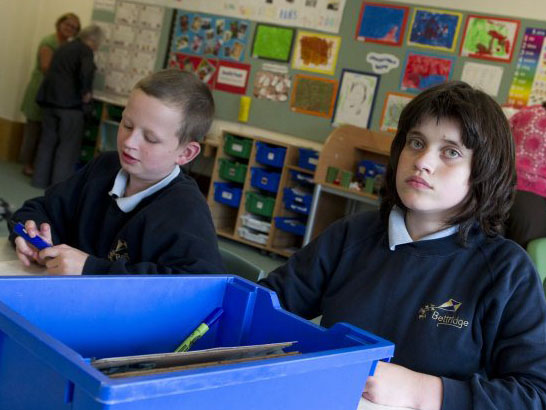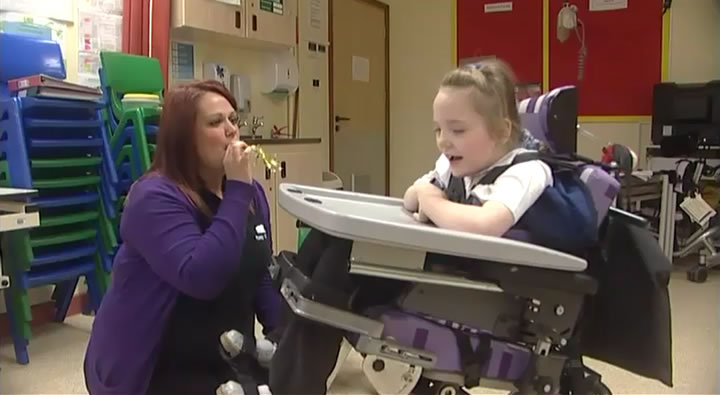
Psychological theories debate the extent to which language development depends on brain development. Many theorists point to the contribution of the environment to the development of a child's communication.
In the case of children with learning difficulties, their biological make-up may significantly influence their finite capacity for acquiring language and communication skills, however through controlling the environment there is scope to maximise a child's potential for communication.
Parents instinctively stimulate a child's language development from an early age by, for example:
- Talking and listening carefully to children;
- Trying to understand their meaning;
- Following children's agendas;
- Asking open-ended questions, not just 'yes-no' questions;
- Pitching intervention just beyond children's current competence;
- Expanding their statements into a longer grammatically correct forms;
- Checking that they understand children's meanings;
- Naming things in the environment;
- Responding to children's curiosity;
- Reading to children;
- Knowing children's prior understanding; and
- Offering a good language model, eg using adverbs and adjectives and finishing sentences.
Educators can usefully adopt this positive way of building on a child's utterances.

When an older child engages in early communication, it can be easy to miss their expressive intentions. It is crucial therefore to spend time getting to know the child – how they express likes, dislikes, and observing their capabilities on which to build interaction.
Watch the film clip in which Leanne, a teaching assistant, tries to establish how Alice expresses that she likes or dislikes something.

Interacting with early intentional communicators should be more like a conversation:
- Follow the child's lead;
- Assume the child is trying to communicate;
- Make sure you always respond in some way to the child's attempt to communicate;
- Only provide corrective feedback in a positive way, praising their effort. Don't blame the child for inaccuracy, rather, use it as an opportunity for clarification;
- Talk with the child, rather than at them, limiting instructions and directives;
- Simplify your language and support it with facial expressions, gestures or signs; and
- Treat the child with respect as a communicator.

Observe your colleagues. Note how they respond to and initiate communication with children who are at the earliest stages of intentional communication.
Is the child engaged by adults in conversation?
To what extent is the child enabled to contribute to the interaction?
Focus on a child who is at the earliest stages of intentional communication.
Referring to this patterns of development chart:
- Determine the child's level of communication compared with the patterns of typical development described.
- Does the child have relative strengths in a particular aspect?
- How do current communication programmes for the child:
- build on strengths
- address weaknesses
- Are the activities age appropriate, as well as developmentally appropriate?
- Review the programme in the light of what you have learnt so far in this module and make any improvements.
- Evaluate the effect of these improvements, over time, on the child's language development.
The following should be learning objectives for intentional early communicators:
- Extending intentional pre-verbal communication – eg by indicating a need, wish or choice through selecting, pointing, eye-pointing, directing gaze;
- Establishing first words and/or signs;
- Learning to use augmentative and/or alternative communication – gaining technical control;
- Using words in a variety of ways – these need to be meaningful to the child, otherwise they will be forgotten or used just for labelling; and
- More extended language use – combining ideas into phrases.
Identifying learning objectives (1)
Identify the learning objectives in each of the following teaching sessions:
-
 Ellie Mae2:49
Ellie Mae2:49 -
 Olivia and teacher1:01
Olivia and teacher1:01 -
 Snack time2:53
Snack time2:53 -
 Balamory2:29
Balamory2:29
Identifying learning objectives (2)
Identify the learning objectives in each of the following teaching sessions:
-
 Blowing group5:06
Blowing group5:06 -
 Hungry caterpillar3:21
Hungry caterpillar3:21 -
 Using switches4:59
Using switches4:59

Read the full model of Halliday's early functional uses of language.
Lacey, P and Fergusson, A (eds) (2005) 'Unit 2: Learning to Communicate', Module 11 18260/11 18276 Learning Difficulties (Severe, Profound and Complex) Communication and Behaviour. Birmingham: University of Birmingham, p 23.
Also, read the following transcripts of adults and children talking for more information on 'Early communication in action'.
What features characterise the adult's talk in the two extracts?
